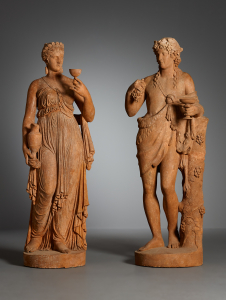Terracotta Buste of a Woman with Shame Mask
Terracotta Buste of a Woman with Shame Mask
A surprisingly freely modeled bust of a woman wearing a ‘mask of shame’ and sticking out her tongue, with an intriguing connotation.
Where would this bust have lived? Let’s first look at the meaning of the mask and the sticking out of the tongue. At the time, being forced to wear a mask of shame was a punitive measure of equal order to the pillory, the Spanish coat, branding, and whipping. In medieval Europe, when imprisonment was not common for lesser offenses, these punishments were imposed on culprits to offend, dishonor, or humiliate them and to expose them to the public. It wasn’t until the 18th century before this type of penalization fell into disuse. The person involved was publicly exposed, by means of a tour around the town or village, or presented at a square or central venue where often the offender was mocked, spotted, or pelted with rotting fruit or vegetables and horse figs. The abetted spectators were not seldom inclined to also throw stones and other hard objects. A mask like this, to some extent, protected the culprit from being hit to hard or suffer injuries that would induce permanent injury or death. The duration of wearing such a mask depended upon the offense, the individual and also local customs. The mask of shame was a punishment typically applied to women, predominantly for infractions that disrupted public order like gossiping, insulting, or lying.
The act of sticking out the tongue to others meant offense, foolishness, adulteration, or offensiveness. Already early on in the middle ages this gesture was applied to images of devils from hell, but also on sinners, pagans, or gluttons. A prominent example is the representation of the Passion where people stick out their tongue to Christ. In the sculpture at hand, the gesture symbolizes vulgarity, obscenity, and foolishness. The tongue and thick lips represented the boundary between inside and outside; the physical and the spiritual.
The explanation of the most prominent features of the object are an indication that this bust was most likely to be placed in a ‘dolhuys’ or prison. The Dolhuys (fools house – or literally house for the ‘dizzy’) was an institution in the middle ages were fools and rioters were incarcerated.
- Period
- ca. 1650-1670
- Material
- Terracotta
- Dimensions
- 28.5 x 34 x 24 cm
Global shipping available







